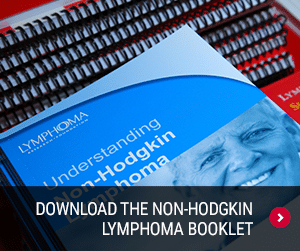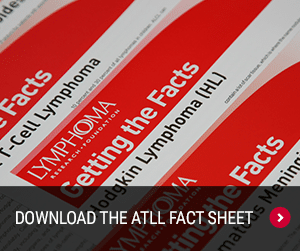
What is Lymphoma?
Adult T-Cell Leukemia/Lymphoma
Adult T-cell leukemia/lymphoma (ATLL) is a rare and often aggressive (fast-growing) T-cell lymphoma that can be found in the blood (leukemia), lymph nodes (lymphoma), skin, or multiple areas of the body.
ATLL has been linked to infection with the human T-cell lymphotropic virus type 1 (HTLV-1); however, less than five percent of individuals with HTLV-1 will develop ATLL. The HTLV-1 virus is most common in parts of Japan, the Caribbean, and some areas of South and Central America and Africa. Currently, physicians have no way of predicting which infected patients will develop ATLL.
Subtypes of ATLL
There are four types of ATLL:
- Acute: This aggressive type of ATLL may develop rapidly and include fatigue, skin rash, and enlarged lymph nodes in the neck, underarm, or groin.
- Lymphomatous: This aggressive type of ATLL is found primarily in the lymph nodes but may also cause high white blood cell counts.
- Chronic: This slow-growing type of ATLL can result in elevated lymphocytes in the blood, enlarged lymph nodes, skin rash or fatigue.
- Smoldering: This slow-growing type of ATLL is associated with very mild symptoms, such as a few skin lesions.
Depending on the subtype, diagnosis ATLL may require removing a small sample of tumor tissue or abnormal skin tissue called a biopsy, and looking at the cells under a microscope.
To learn about treatments under investigation for ATLL, download the Adult T-Cell Leukemia/Lymphoma Fact Sheet.
To learn more about a specific type of lymphoma, select from the following menu:
- Adolescent and Young Adult Lymphoma
- Adult T-Cell Leukemia/Lymphoma
- Anaplastic Large Cell Lymphoma
- Angioimmunoblastic T-Cell Lymphoma
- Burkitt Lymphoma
- Chronic Lymphocytic Leukemia
- Cutaneous B-Cell Lymphoma
- Cutaneous T-Cell Lymphoma
- Diffuse Large B-Cell Lymphoma
- Double-Hit Lymphoma
- Follicular Lymphoma
- Hodgkin Lymphoma
- Mantle Cell Lymphoma
- Marginal Zone Lymphoma
- Non-Hodgkin Lymphoma
- Peripheral T-Cell Lymphoma
- Primary Central Nervous System Lymphoma
- T-Cell Lymphoma
- Transformed Mycosis Fungoides
- Waldenstrom Macroglobulinemia


